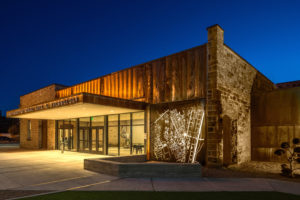
Photo: Kirk Gittings
Las Vegas, N.M. – Highlands University received a New Mexico Architectural Heritage award for transforming a unique Las Vegas historical landmark into a state-of-the art facility for the university’s Media Arts and Technology Department.
The New Mexico Department of Cultural Affairs Historic Preservation Division tapped the Highlands Trolley Building for the honor.
“The project is an outstanding adaptive reuse of a significant building in Las Vegas’s history,” said Rick Hendricks, DCA’s Cultural Properties Review Committee chair. “The committee was impressed that the new architecture complements the historic and conveys the building’s new purpose.”
The Trolley Building was constructed in 1905 when Las Vegas was a bustling city that boasted one of only two electric trolley systems in the state. The trolley system operated until 1926. Highlands purchased the building in 1966.
Built is the classic Romanesque style, every standing exterior wall and window was preserved in the renovation, which blends history with a sleek modern industrial design. The project architect is Mark Baker, principal with Baker Architecture +Design of Albuquerque.
“The Trolley Building stands as an outstanding example of what can happen when someone sees beyond a crumbling historic ruin and envisions a building dedicated to learning,” said Rudy Lambaugh, Las Vegas Citizens’ Committee for Historic Preservation chair. “The shell of the Trolley Building has been creatively restored and expanded to become a world-class facility for Highlands University’s media arts program.”
The Trolley Building includes classroom labs with computer workstations featuring the latest design and multimedia software, a modern television studio for creating video, labs for studio photography and audio mixing, an electronics maker space, 3-D printers, and more features.
Kerry Loewen has served as department chair for the Media Arts and Technology Department since 2012.
“This building would never have happened without the vision and persistence of Miriam Langer, former media arts chair, and Katherine Slick, former state historian,” Loewen said. “What’s great about this building is that it combines cutting-edge technology with the character and feel of a historic landmark.
“With the Trolley Building, we’re able to offer our students the kind of exceptional learning experience found at much larger universities,” Loewen said.
Classes began in the 21,207-square-foot Trolley Building Aug. 17, 2016.
Loewen said the Architectural Heritage Award is shared with Mark Baker and his architectural team, Franken Construction of Las Vegas, the general contractor, and Sylvia Baca, Highlands University’s facilities and planning director, the project manager for the Trolley Building.
“The outstanding team took the concepts for the Trolley Building and made them into reality of bricks and mortar,” Baca said. “Baker Architecture + Design was committed to creating a unique, absolutely notable design, our construction manager Clay Simmons from Progressive Construction was an incredible help to me and kept the project on task, and Franken Construction offered solid solutions throughout.”
Baca said the Architectural Heritage Award for the Trolley Building highlights Highlands University’s continued dedication to preserving its treasured historic buildings.
Some architectural features include exposed sandstone walls and polished concrete floors inlaid with stainless steel rails to evoke the history of the trolley cars that rolled into the building. Original ironwork is exposed to add more historical flavor. A preserved steel trolley barn door and large laser-cut historic map of Las Vegas grace the entrance. A salvaged trolley wheel forms the base for a striking glass conference room table.
Despite a number of construction challenges like a tunnel system with fortified concrete walls and hitting groundwater from the nearby Gallinas River, the project was completed on time and within budget.
The construction phase for the Trolley Building was from 2015 to 2016. The total project cost is $8.3 million, the majority coming from voter-approved general obligation bonds.
